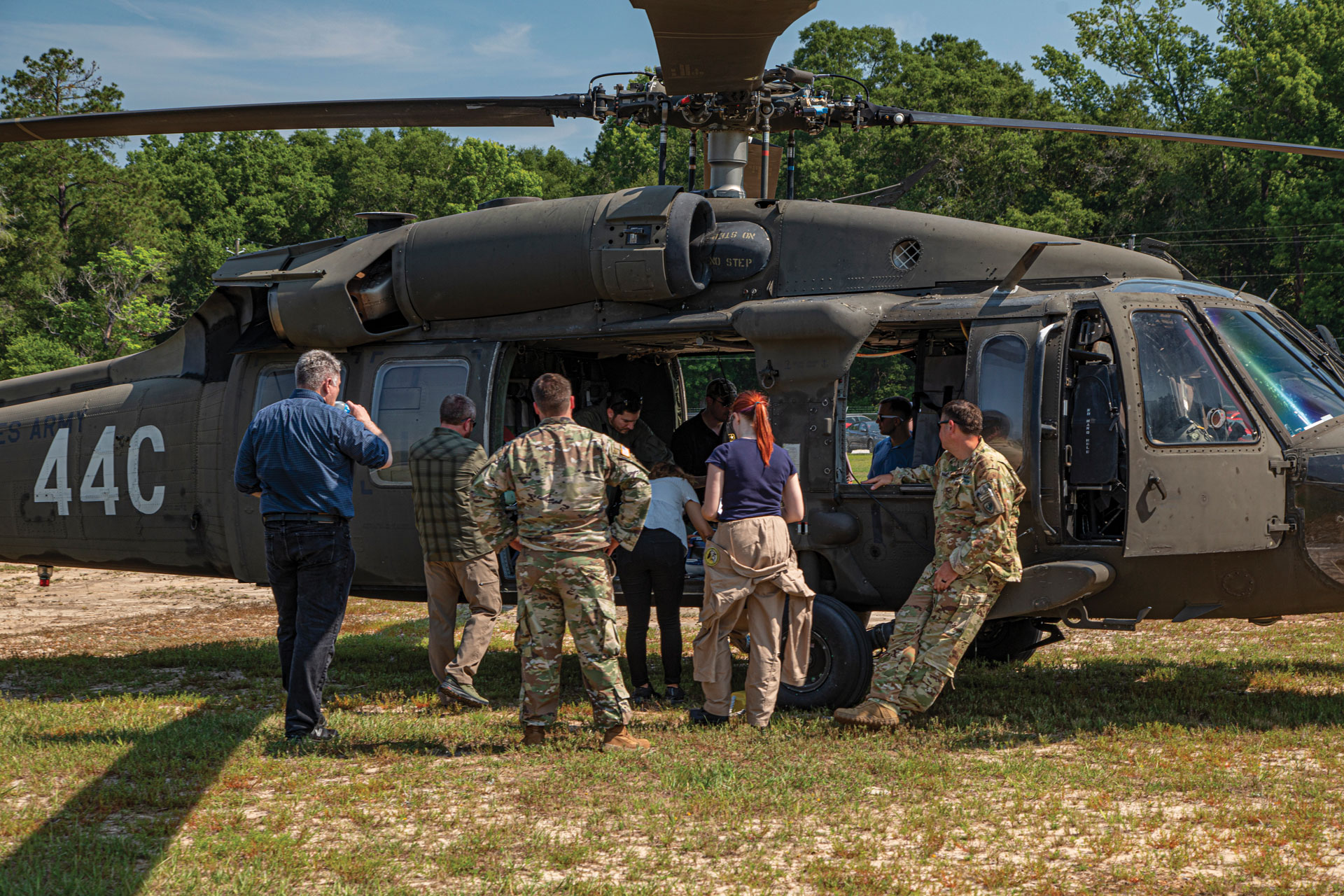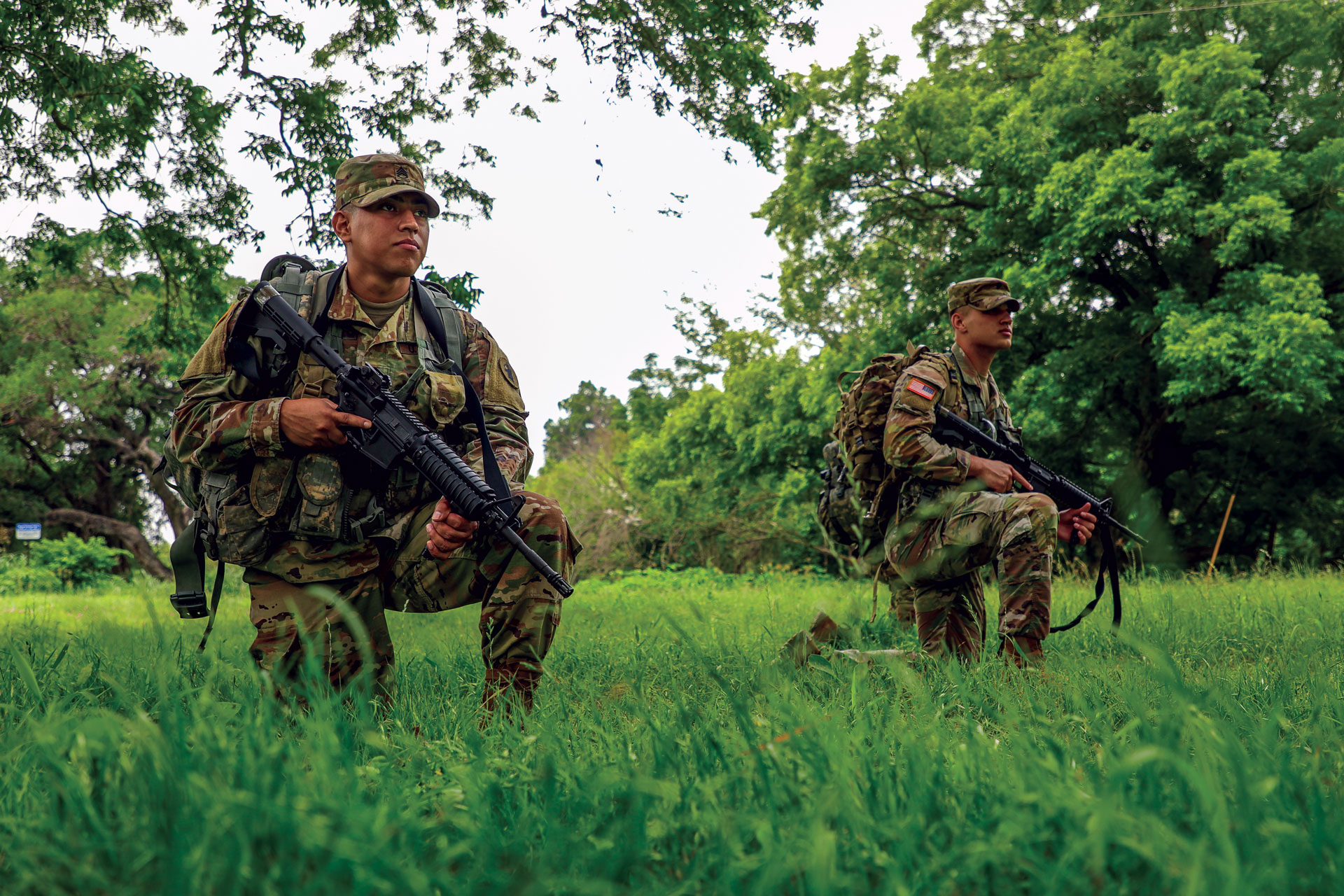
WORKING TOGETHER, GETTING RESULTS: A U.S. Army Aeromedical Research Laboratory flight paramedic tests new items in a space utilization study at the School of Aviation Medicine’s DUSTOFF Training complex at Fort Rucker, Alabama. (Photo by Scott C Childress, Medical Research and Development Command)
From the Army Acquisition Executive
Douglas R. Bush (Acting)
Army acquisition is meeting our mission to develop, acquire and deliver needed capability to our Soldiers.
“Seeing our modernization programs through successfully will remain a top priority so that the Army is ready to meet future challenges.”
—Honorable Christine E. Wormouth, Secretary of the Army

Douglas R. Bush, Army Acquisition Executive (Acting)
The theme of this issue, “Enabling Modernization,” is an especially timely one as I write my introductory column for this award-winning publication. We have a lot going on in the Army acquisition, logistics and technology community, and I am continually impressed by the dedication and resilience of the more than 43,000 professionals who comprise our workforce. Even in the midst of a global pandemic, this team kept adapting, moving forward and getting the job done. I see the results firsthand, and I am proud to acknowledge that in nearly every case our programs are on time and on schedule. This, of course, means that we are meeting our mission to develop, acquire and deliver needed capability to the Army and our Soldiers.
In this context of enabling modernization, it is important to remember that we are one entity in the greater Army modernization enterprise. Modernization, as often said, is a team sport. It takes the entire team working together to succeed. In the last few months, I’ve had the opportunity to visit many of our program executive offices (PEOs) for equipment updates, overviews and demonstrations. I learned of their good working relationships with the Army Future Command’s (AFC) cross-functional teams, and saw the results of their efforts. I traveled to Austin, Texas, to meet one-on-one with Gen. John M. Murray, AFC’s commander, and to get acquainted with his team. Murray and I collaborate closely, and recently testified to both the Senate and House armed services committees on the fiscal year 2022 budget and Army modernization. I also visited several of our organizations in Huntsville, Alabama, and met with Gen. Edward E. Daly, commanding general of the U.S. Army Materiel Command (AMC), another vital member of the Army modernization enterprise. We, too, engage frequently on a number of areas of interest, including one of AMC’s major subordinate commands, the Army Contracting Command, which is absolutely indispensable to our work in acquisition.
My emphasis, and this is something I often tell my team, is on cooperation, coordination and unity of effort. While there are many people and organizations involved in Army modernization, we all share the same goal—to provide our men and women in uniform with the best equipment possible in the event that our Army, on behalf of the nation, has to go to war. In the meantime, our plan is to provide capability that is so intimidating that we are able to deter conflict in the first place.
I had the privilege of working on Capitol Hill for two decades with nearly 15 years on the House Armed Services Committee, where I was responsible for oversight of Army modernization programs. During those years, I watched Army leaders work through difficult decisions, make tradeoffs, and try to develop achievable requirements while following the laws that Congress had put in place. It is very different to be inside the organization now where I am responsible for Army modernization programs, but I’ve had valuable training for this job from my prior experience.

TEAM EFFORT: The U.S. Army Aeromedical Research Laboratory (USAARL) conducted Medical Hands-free Unified Broadcast (MEDHUB) airworthiness and aeromedical certification testing on the UH-60L and HH-60M Black Hawk helicopters. This testing, critical to ensuring the system is ready for demonstration at Project Convergence 21, was a multi-organization effort between PEO Aviation, U.S. Army Medical Materiel Development Activity, School of Army Aviation Medicine, Sierra Nevada Corp. and USAARL. (Photo by Scott C Childress, Medical Research and Development Command)
Let me share with you a couple of observations. First, the Army has struggled at times in the past with developing requirements that were realistic to achieve within the funding and modernization timelines the Army was given. As a result, acquisition programs sometimes suffered. Another observation is that the Army, in the past, was inconsistent with its priorities—changing too often and, in some cases, when real progress had begun. On these two fronts, now that I am inside the Army, I see a lot of cause for optimism.
On the first issue regarding requirements, I’m deep into the programs and seeing things at work. From my vantage point, the requirements the acquisition community are getting from the Army—AFC and others—are achievable, thought-through, and informed by Soldier feedback, experimentation and demonstrations. All the things we need to do to get requirements that we can work with industry to achieve. I see great progress in this area.
Secondly, the Army priorities—the Big Six or 31+4—have actually received very consistent and strong support from Army leadership over many years now, which is critical and will continue to be critical in getting and retaining the resources we need to get these systems fielded. Consistency of priorities is also good for our industry partners, so their work on research and development meets up with our needs.

ONE GOAL: “We all share the same goal—to provide our men and women in uniform with the best equipment possible.” (Photo by Pfc. Joshua Taeckens, U.S. Army South)
So these three overall factors—teamwork across the Army, solid requirements and consistent priorities—make me optimistic that the Army can achieve its ambitious goal of across-the-board modernization for the first time in almost 40 years.
It is important to remember that in combat, the Army fights as a team. It should be no different within the Army modernization enterprise.







